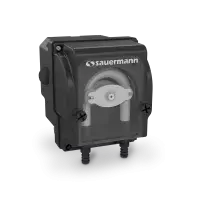Condensate pumps are an essential component of HVAC-R systems, ensuring their proper operation and preventing damage caused by the accumulation of condensation water formed during the heating or cooling process.
This liquid, called condensate, can cause serious damage to the HVAC-R systems themselves, or to the buildings in which they are installed. The main dangers are water damage, electrical problems, rust and oxidation or even mould formation which can then spread through the ventilation ducts and into the ambient air.
What is the role of a condensate pump?
A condensate pump consists of a detection part located within a tank where the condensate flows. Above a certain level, the condensate triggers the activation of the pump, which will suck up the condensate and lift it to a drainage circuit provided for this purpose. This pump is therefore necessary when it is not possible to evacuate the condensate by the simple effect of gravity, which will make the condensation liquid flow by itself into a drainage circuit.
Avoiding condensate leaks will prevent certain risks of breakdown or water damage, and even certain health problems for the occupants of the building (mould in the ambient air). Condensate pumps therefore contribute to the structural preservation of the building, to the life and efficiency of the heating, air conditioning or refrigeration system, and to the indoor air quality (IAQ).
The different types of condensate pumps
HVACR installations differ according to their role, but also according to the size of the volumes to be heated or cooled. The power of the installation will generate more or less condensate, at different temperatures and with various compositions (particles, acidity, pollution, etc.). For each type of system, there is therefore a type of condensate pump to be preferred.
Mini pumps
Mini pumps are designed for low to medium capacity air conditioning systems: console, split, cassette, domestic or tertiary type air conditioners, for units up to about 20 kW. These mini pumps are therefore designed to discharge a medium quantity of condensate, and are above all designed to be discreetly integrated into an installation, invisibly and silently, with a small detection tank, sometimes external to the pump unit.
Tank pumps
Reservoir pumps, or tank pumps, are designed for more powerful systems, producing a larger quantity of condensate, and sometimes of a more aggressive nature. These tend to come from combustion boiler systems, which produce more acidic condensate that is very hot and polluted with certain substances from the combustion process. The detection part of these pumps is contained in a large tank attached to the pump block. Power and resistance are the priorities for these pumps.
Peristaltic pumps
Peristaltic pumps (or roller pumps) have a process of pumping by pressing a flexible tube to drive the fluid avoiding contact with a component outside its circulation circuit. They are mainly used to avoid contamination of the pumped liquid, but they can also be used in air conditioning systems due to their small size and low noise level.
Refrigerated display case pumps
Refrigerated display pumps are tank pumps that are shaped as flat as possible to fit under the refrigerated (fresh or frozen) shelves of supermarkets. As with tank pumps, they must be particularly efficient and durable, as they discharge a large amount of condensate that is highly loaded with particles and biofilm.
How to choose the right condensate pump?
The choice of a condensate pump depends on the system in which it will be installed. It all depends on the power of the heating or cooling system and sometimes on the nature of the condensate it will generate (polluted and greasy in a kitchen or hairdresser's, acidic for boilers, etc.).
Other conditions for the choice of a condensate pump: the available space in which it will be installed, which will determine its shape or size, but also the type of room where it will operate, which will determine the trade-off between its noise pollution and its power.
How should a condensate pump be maintained?
To maintain a condensate pump, it is recommended to call in a professional about once a year, and sometimes more often when the pump is exposed to ambient air loaded with substances or particles (flour in a bakery, etc.). More generally, it is possible to inspect its detection system and the (often transparent) exhaust ducts for dirt.
For more information, see our two blog posts:
- Air conditioner: 10 checks to prevent a water leak
- How and why to clean an air conditioner's condensate pump?
When should I change my condensate pump?
A condensate pump can last for years if it is properly maintained. Replacement is recommended if there is a severe breakdown, or if it is in an advanced state of wear and tear, which a professional will be able to anticipate, particularly by assessing the noise caused by the pump during operation.
Can I install a condensate pump myself?
Some condensate pumps are relatively simple to install, but it is strongly recommended that a professional be called in for this type of operation in order to ensure that it works properly and to avoid any risk, especially electrical.
More information in our blog articles:







